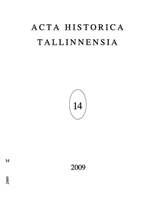MISJONÄR VÕI MÕISNIK? TSISTERTSLASTE ROLL 13. SAJANDI EESTIS
MISSIONARIES OR MANORIAL LORDS? THE ROLE OF CISTERCIANS IN THIRTEENTH-CENTURY ESTONIA
Author(s): Kersti MarkusSubject(s): History
Published by: Teaduste Akadeemia Kirjastus
Keywords: Estonia; Estonian History; MISSIONARIES OR MANORIAL LORDS; ROLE OF CISTERCIANS ; THIRTEENTH-CENTURY ESTONIA
Summary/Abstract: This article examines the activity of Cistercians in Estonia during the thirteenth century, combining written source material with landscape history. While previous research has focused on the Cistercians’ missionary involvement in the late twelfth and early thirteenth century Danish and German crusades to Livonia and Estonia, this study aims to demonstrate the order’s influence on establishing a manorial system in some of the Estonian provinces. The foundation of the monastery of Falkenau [Estonian Valkena] near Dorpat [Tartu] in 1233 by Hermann, bishop of Dorpat, can be explained in the light of missionary activities in the provinces of central Estonia. However, although it was an episcopal foundation, also the Papal Legate Baudouin of Aulne might have played an important role in establishing the monastery. Moreover, the land owned by the monks was not located in the bishopric of Dorpat. Instead, they built up a grange (grangium) in Alp [Albu] in Jerwen county [Järvamaa], which was an isolated place near the Danish border surrounded by marshland. This part of central Estonia was administered by the Papal Legate in the 1230s and by the Teutonic Order thereafter. Two other granges owned by Falkenau monastery were located in the Danish territory, one not far from Wesenberg [Rakvere] in Mädapea, wherefrom the monks obtained valuable building timber, and the other on the coast of Wierland [Virumaa] near Aa, which gave them access to iron production and salt water fishing. Falkenau was the only monastery founded in Estonia during the thirteenth century, but not the only monastic community who owned land in this region. As early as between 1223 and 1227, Duke Knut, the Danish viceroy in Estonia, donated the territory near the eastern border of Harrien county [Harjumaa] in Danish Estonia to the Gotlandic Cistercian monastery of Roma. It was a suitable area for large-scale farming and fishing, and probably even for trading thanks to the harbour by the hill fort of Muuksi. The grange in Kolk [Kolga] was formed from benefactions, supplemented by purchases, exchanges and land clearance. By the end of the thirteenth century the monks possessed the majority of the lands in Kusal [Kuusalu] parish, even the village of Kusal, which may indicate that the church of Kusal stood under their patronage as well. Also the Cistercian monastery of Dünamünde [Latvian Daugavgrīva] near Riga obtained extensive areas of land in the western part of Harrien county. There the landscape was mostly made up of bogs and forests. However, on its grange at Paeküla (Padise) a limestone quarry was available and at Raasiku an excellent place to obtain iron ore. According to sources there was a chapel at Padise, which was subordinated to the parish church of Hertele and shared by lay brothers and local inhabitants.
Journal: Acta Historica Tallinnensia
- Issue Year: 2009
- Issue No: 14
- Page Range: 003-030
- Page Count: 28
- Language: Estonian

